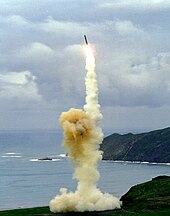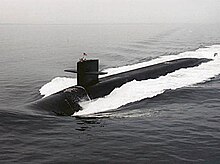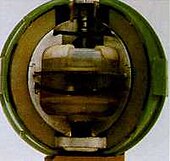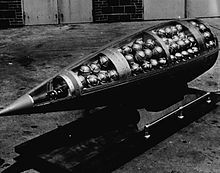| United States | |
|---|---|
 | |
| Nuclear program start date | 21 October 1939 |
| First nuclear weapon test | 16 July 1945 |
| First fusion weapon test | 1 November 1952 |
| Last nuclear test | 23 September 1992 |
| Largest yield test | 15 Mt (1 March 1954) |
| Total tests | 1,054 detonations |
| Peak stockpile | 32,040 warheads (1967) |
| Current stockpile (usable and not) | 6,185 total6,185 (2019) |
| Current strategic arsenal | 1,600 methods of delivery (including ICBMs, Bombers, and including MIRVed warheads on SLBMs) (2019) |
| Cumulative strategic arsenal in megatonnage | ≈1430 (2014) |
| Maximum missile range | 13,000 km (8,078 mi) (land) 12,000 km (7,456 mi) (sub) |
| NPT party | Yes (1968, one of five recognized powers) |
The United States is known to have possessed three types of weapons of mass destruction: nuclear weapons, chemical weapons, and biological weapons. The U.S. is the only country to have used nuclear weapons in combat, when it detonated two atomic bombs over the Japanese cities of Hiroshima and Nagasaki during World War II. It had secretly developed the earliest form of the atomic weapon during the 1940s under the title "Manhattan Project". The United States pioneered the development of both the nuclear fission and hydrogen bombs (the latter involving nuclear fusion). It was the world's first and only nuclear power for four years (1945–1949), until the Soviet Union managed to produce its own nuclear weapon. The United States has the second largest number of nuclear weapons in the world, after Russia.
Nuclear weapons
U.S. nuclear warhead stockpiles, 1945-2002.
Nuclear weapons have been used twice in combat: two nuclear weapons were used by the United States against Japan during World War II in the atomic bombings of Hiroshima and Nagasaki. Altogether, the two bombings killed 105,000 people and injured thousands more while devastating hundreds or thousands of military bases, factories, and cottage industries.
The U.S. conducted an extensive nuclear testing program.1054
tests were conducted between 1945 and 1992. The exact number of nuclear
devices detonated is unclear because some tests involved multiple
devices while a few failed to explode or were designed not to create a
nuclear explosion. The last nuclear test by the United States was on
September 23, 1992; the U.S. has signed but not ratified the Comprehensive Nuclear-Test-Ban Treaty.
Currently, the United States nuclear arsenal is deployed in three areas:
- Land-based intercontinental ballistic missiles, or ICBMs;
- Sea-based, nuclear submarine-launched ballistic missiles, or SLBMs; and
- Air-based nuclear weapons of the U.S. Air Force's heavy bomber group
The United States is one of the five "Nuclear Weapons States" under the Treaty on the Non-Proliferation of Nuclear Weapons, which the U.S. ratified in 1968. On October 13, 1999, the U.S. Senate rejected ratification of the Comprehensive Test Ban Treaty, having previously ratified the Partial Test Ban Treaty in 1963. The U.S. has not, however, tested a nuclear weapon since 1992, though it has tested many non-nuclear components and has developed powerful supercomputers in an attempt to duplicate the knowledge gained from testing without conducting the actual tests themselves.
In the early 1990s, the U.S. stopped developing new nuclear weapons and now devotes most of its nuclear efforts into stockpile stewardship, maintaining and dismantling its now-aging arsenal. The administration of George W. Bush decided in 2003 to engage in research towards a new generation of small nuclear weapons, especially "earth penetrators". The budget passed by the United States Congress in 2004 eliminated funding for some of this research including the "bunker-busting or earth-penetrating" weapons.
The exact number of nuclear weapons possessed by the United
States is difficult to determine. Different treaties and organizations
have different criteria for reporting nuclear weapons, especially those
held in reserve, and those being dismantled or rebuilt:
- In its Strategic Arms Reduction Treaty (START) declaration for 2003, the U.S. listed 5968 deployed warheads as defined by START rules.
- The exact number as of September 30, 2009, was 5,113 warheads, according to a U.S. fact sheet released May 3, 2010.
In 2002, the United States and Russia agreed in the SORT treaty to reduce their deployed stockpiles to not more than 2,200 warheads each. In 2003, the U.S. rejected Russian proposals to further reduce both nation's nuclear stockpiles to 1,500 each.
In 2007, for the first time in 15 years, the United States built new
warheads. These replaced some older warheads as part of the Minuteman III upgrade program.
2007 also saw the first Minuteman III missiles removed from service as
part of the drawdown. Overall, stockpiles and deployment systems
continue to decline in number under the terms of the New START treaty.
In 2014, Bulletin of the Atomic Scientists
released a report, stating that there are a total of 2,530 warheads
kept in reserve, and 2,120 actively deployed. Of the warheads actively
deployed, the number of strategic warheads rests at 1,920 (subtracting
200 tactical B61s
as part of Nato nuclear weapon sharing arrangements). The amount of
warheads being actively disabled rests at about 2,700 warheads, which
brings the total United States inventory to about 7,400 warheads.
Land-based ICBMs
A Minuteman III ICBM test launch.
The U.S. Air Force currently operates 400 Minuteman III ICBMs, located primarily in the northern Rocky Mountain states and the Dakotas. Peacekeeper missiles were phased out of the Air Force inventory in 2005. All USAF Minuteman II
missiles were destroyed in accordance with the START treaty and their
launch silos imploded and buried then sold to the public under the START II.
The U.S. goal under the SORT treaty was to reduce from 1,600 warheads
deployed on over 500 missiles in 2003 to 500 warheads on 450 missiles in
2012. The first Minuteman III were removed under this plan in 2007
while, at the same time, the warheads deployed on Minuteman IIIs began
to be upgraded from smaller W62s to larger W87s from decommissioned Peacekeeper missiles.
Air-based delivery systems
The U.S. Air Force also operates a strategic nuclear bomber fleet. The bomber force consists of 36 nuclear-armed B-52 Stratofortresses, and 20 B-2 Spirits. All 64 B-1s were retrofitted to operate in a solely conventional mode by 2007 and thus don't count as nuclear platforms.
In addition to this, the U.S. military can also deploy smaller tactical nuclear weapons either through cruise missiles or with conventional fighter-bombers. The U.S. maintains about 400 nuclear gravity bombs capable of use by F-15, F-16, and F-35. Some 350 of these bombs are deployed at seven airbases in six European NATO countries; of these, 180 tactical B61 nuclear bombs fall under a nuclear sharing arrangement.
Sea-based Ballistic Missiles
The U.S. Navy currently has 18 Ohio-class submarines deployed, of which 14 are ballistic missile submarines. Each submarine is equipped with a maximum complement of 24 Trident II missiles. Approximately 12 U.S. attack submarines were equipped to launch nuclear Tomahawk missiles, but these weapons were removed from service by 2013.
The number of Deployed and Non-Deployed SLBMs on the Ohio-Class SSBNs as of 2018 is 280, of which 203 SLBMs are deployed.
Biological weapons
The United States offensive biological weapons program was instigated by President Franklin Roosevelt and the U.S. Secretary of War in October 1941. Research occurred at several sites. A production facility was built at Terre Haute, Indiana but testing with a benign agent demonstrated contamination of the facility so no production occurred during World War II. A more advanced production facility was constructed in Pine Bluff, Arkansas, which began producing biological agents in 1954. Fort Detrick, Maryland
later became a production facility as well as a research site. The U.S.
developed anti-personnel and anti-crop biological weapons.
Several deployment systems were developed including aerial spray tanks,
aerosol spray canisters, grenades, rocket warheads and cluster bombs.
E120 biological bomblet, developed before the U.S. ratified the Biological Weapons Convention.
In mid-1969, the UK and the Warsaw Pact, separately, introduced
proposals to the UN to ban biological weapons, which would lead to a
treaty in 1972. The U.S. cancelled its offensive biological weapons
program by executive order
in November 1969 (microorganisms) and February 1970 (toxins) and
ordered the destruction of all offensive biological weapons, which
occurred between May 1971 and February 1973. The U.S. ratified the Geneva Protocol on January 22, 1975. The U.S. ratified the Biological Weapons Convention (BWC) which came into effect in March 1975.
Negotiations for a legally binding verification protocol to the BWC proceeded for years. In 2001, negotiations ended when the Bush administration
rejected an effort by other signatories to create a protocol for
verification, arguing that it could be abused to interfere with
legitimate biological research.
The U.S. Army Medical Research Institute of Infectious Diseases, located in Fort Detrick, Maryland,
produces small quantities of biological agents, for use in biological
weapons defense research. According to the U.S. government, this
research is performed in full accordance with the BWC.
In September 2001, shortly after the September 11 terrorist attacks on the United States, there was a series of mysterious anthrax attacks aimed at U.S. media offices and the U.S. Senate which killed five people. The anthrax used in the attacks was the Ames strain, which was first studied at Fort Detrick and then distributed to other labs around the world.
Chemical weapons
In World War I, the U.S. had its own chemical weapons program, which produced its own chemical munitions, including phosgene and mustard gas.
The U.S. only created about 4% of the total chemical weapons produced
for that war and just over 1% of the era's most effective weapon,
mustard gas. (U.S. troops suffered less than 6% of gas casualties.)
Although the U.S. had begun a large-scale production of Lewisite, for use in an offensive planned for early 1919, Lewisite was not deployed during World War I. The United States also created a special unit, the 1st Gas Regiment, which used phosgene in attacks after being deployed to France.
Chemical weapons were not used by the Allies or Germany during World War II
for military purposes, but such weapons were deployed to Europe from
the United States. In 1943, German bombers attacked the port of Bari in Southern Italy, sinking several American ships – among them John Harvey,
which was carrying mustard gas. The presence of the gas was highly
classified, and, according to the U.S. military account, "Sixty-nine
deaths were attributed in whole or in part to the mustard gas, most of
them American merchant seamen" out of 628 mustard gas military
casualties.
The affair was kept secret at the time and for many years. After the
war, the U.S. both participated in arms control talks involving chemical
weapons and continued to stockpile them, eventually exceeding 30,000 tons of material.
Honest John missile warhead cutaway, showing M134 Sarin bomblets (photo c. 1960)
After the war, all of the former Allies pursued further research on the three new nerve agents developed by the Nazis: tabun, sarin, and soman. Over the following decades, thousands of American military volunteers were exposed to chemical agents during Cold War
testing programs, as well as in accidents. (In 1968, one such accident
killed approximately 6,400 sheep when an agent drifted out of Dugway Proving Ground during a test.) The U.S. also investigated a wide range of possible nonlethal, psychobehavioral chemical incapacitating agents including psychedelic indoles such as LSD and marijuana derivatives, as well as several glycolate anticholinergics. One of the anticholinergic compounds, 3-quinuclidinyl benzilate, was assigned the NATO
code BZ and was weaponized at the beginning of the 1960s for possible
battlefield use. Alleged use of chemical agents by the U.S. in the Korean (1950–53) conflict has never been substantiated.
In late 1969, President Richard Nixon unilaterally renounced the first use of chemical weapons (as well as all methods of biological warfare).
He issued a unilateral decree halting production and transport of
chemical weapons which remains in effect. From 1967 to 1970 in Operation CHASE, the U.S. disposed of chemical weapons by sinking ships laden with the weapons in the deep Atlantic.
The U.S. began to research safer disposal methods for chemical weapons
in the 1970s, destroying several thousand tons of mustard gas by
incineration and nearly 4,200 tons of nerve agent by chemical
neutralization.
The U.S. entered the Geneva Protocol in 1975 (the same time it ratified the Biological Weapons Convention).
This was the first operative international treaty on chemical weapons
to which the U.S. was party. Stockpile reductions began in the 1980s,
with the removal of some outdated munitions and destruction of the
entire stock of BZ beginning in 1988. In 1990, destruction of chemical
agents stored on Johnston Atoll in the Pacific began, seven years before the Chemical Weapons Convention (CWC) came into effect. In 1986, President Ronald Reagan began removal of the U.S. stockpile of chemical weapons from Germany.
In 1991, President George H.W. Bush unilaterally committed the U.S. to destroying all chemical weapons and renounced the right to chemical weapon retaliation.
In 1993, the U.S. signed the CWC, which required the destruction
of all chemical weapon agents, dispersal systems, chemical weapons
production facilities by 2012. Both Russia and U.S. missed the CWC's
extended deadline of April 2012 to destroy all of their chemical
weapons. The United States destroyed 89.75% of the original stockpile of nearly 31,100 metric tons (30,609 long tons) of nerve and mustard agents under the terms of the treaty. Chemical weapons destruction resumed in 2015 with expected completion by 2023. The country's last stockpile is at the Blue Grass Army Depot in Kentucky.





